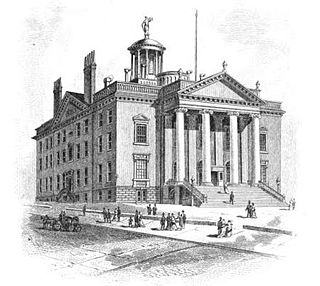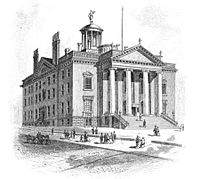Sessions
The Legislature met for the regular session at the Old State Capitol in Albany on January 7, 1851; and adjourned on April 17.
Henry J. Raymond (Whig) was elected Speaker with 80 votes against 42 for Noble S. Elderkin (Dem.). Richard U. Sherman (W) was elected Clerk of the Assembly with 81 votes against 44 for the incumbent James R. Rose (D).
On February 4, the Legislature failed to elect a U.S. Senator to succeed Daniel S. Dickinson (Dem.), and the seat became vacant on March 4, 1851.
On February 25, Joseph B. Varnum Jr. was elected Speaker pro tempore, to preside over the Assembly during the absence of Speaker Raymond.
On March 3, Senator William A. Dart questioned the right of Marius Schoonmaker to keep his seat in the Senate. Schoonmaker had been elected to Congress at the last State election, but Congress would not actually meet until December. After some debate, the Senate decided on March 5 that Schoonmaker "is a member of the present Senate... and will remain so, until he accepts the office of member of Congress, or until he otherwise vacates his seat in the Senate." [1]
On March 19, [2] the Legislature elected Hamilton Fish (W) to the vacant seat in the U.S. Senate.
On April 17, twelve Democratic state senators resigned, leaving the Senate without the necessary quorum of two-thirds to pass "An Act to provide for the completion of the Erie canal enlargement, and the Black River and Genesee Valley canals".
On May 27, a special election was held to fill the vacancies in the State Senate. Six of the resigned senators were re-elected; five vacancies were filled with men who later voted for the passage of the bill; and one election resulted in a tie.
The Legislature met for a special session on June 10, 1851; and adjourned on July 11.
Due to ill health, Speaker Raymond did not attend the special session, and Joseph B. Varnum Jr. was again elected Speaker pro tempore, to preside over the Assembly during the special session. [3]
On June 24, the Canal Enlargement Bill was passed in the Senate by a vote of 22 to 8.
On July 2, the Whig majority admitted their party fellow Wiliam J. Gilbert to the vacant seat.

The 1851 United States Senate election in New York was held on February 4 and March 18–19, 1851, by the New York State Legislature to elect a U.S. Senator to represent the State of New York in the United States Senate.

The 1850–51 United States Senate elections were held on various dates in various states. As these U.S. Senate elections were prior to the ratification of the Seventeenth Amendment in 1913, senators were chosen by state legislatures. Senators were elected over a wide range of time throughout 1850 and 1851, and a seat may have been filled months late or remained vacant due to legislative deadlock. In these elections, terms were up for the senators in Class 1.

The 71st New York State Legislature, consisting of the New York State Senate and the New York State Assembly, met from January 4 to April 12, 1848, during the second year of John Young's governorship, in Albany.

The 72nd New York State Legislature, consisting of the New York State Senate and the New York State Assembly, met from January 2 to April 11, 1849, during the first year of Hamilton Fish's governorship, in Albany.

The 73rd New York State Legislature, consisting of the New York State Senate and the New York State Assembly, met from January 1 to April 10, 1850, during the second year of Hamilton Fish's governorship, in Albany.

The 75th New York State Legislature, consisting of the New York State Senate and the New York State Assembly, met from January 6 to April 16, 1852, during the second year of Washington Hunt's governorship, in Albany.

The 76th New York State Legislature, consisting of the New York State Senate and the New York State Assembly, met in Albany from January 4 to July 21, 1853, during the first year of Horatio Seymour's governorship.

The 77th New York State Legislature, consisting of the New York State Senate and the New York State Assembly, met from January 3 to April 17, 1854, during the second year of Horatio Seymour's governorship, in Albany.

The 78th New York State Legislature, consisting of the New York State Senate and the New York State Assembly, met from January 2 to April 14, 1855, during the first year of Myron H. Clark's governorship, in Albany.

The 79th New York State Legislature, consisting of the New York State Senate and the New York State Assembly, met from January 1 to April 9, 1856, during the second year of Myron H. Clark's governorship, in Albany.

The 80th New York State Legislature, consisting of the New York State Senate and the New York State Assembly, met from January 6 to April 18, 1857, during the first year of John A. King's governorship, in Albany.

The 81st New York State Legislature, consisting of the New York State Senate and the New York State Assembly, met from January 5 to April 19, 1858, during the second year of John A. King's governorship, in Albany.

The 83rd New York State Legislature, consisting of the New York State Senate and the New York State Assembly, met from January 3 to April 17, 1860, during the second year of Edwin D. Morgan's governorship, in Albany.

The 84th New York State Legislature, consisting of the New York State Senate and the New York State Assembly, met from January 1 to April 16, 1861, during the third year of Edwin D. Morgan's governorship, in Albany.

The 86th New York State Legislature, consisting of the New York State Senate and the New York State Assembly, met from January 6 to April 25, 1863, during the first year of Horatio Seymour's second tenure as Governor of New York, in Albany.

The 88th New York State Legislature, consisting of the New York State Senate and the New York State Assembly, met from January 3 to April 28, 1865, during the first year of Reuben E. Fenton's governorship, in Albany.

The 89th New York State Legislature, consisting of the New York State Senate and the New York State Assembly, met from January 2 to April 20, 1866, during the second year of Reuben E. Fenton's governorship, in Albany.

The 90th New York State Legislature, consisting of the New York State Senate and the New York State Assembly, met from January 1 to April 20, 1867, during the third year of Reuben E. Fenton's governorship, in Albany.

The 92nd New York State Legislature, consisting of the New York State Senate and the New York State Assembly, met from January 5 to May 11, 1869, during the first year of John T. Hoffman's governorship, in Albany.

The 93rd New York State Legislature, consisting of the New York State Senate and the New York State Assembly, met from January 4 to April 26, 1870, during the 2nd year term of John T. Hoffman governorship, in Albany.



